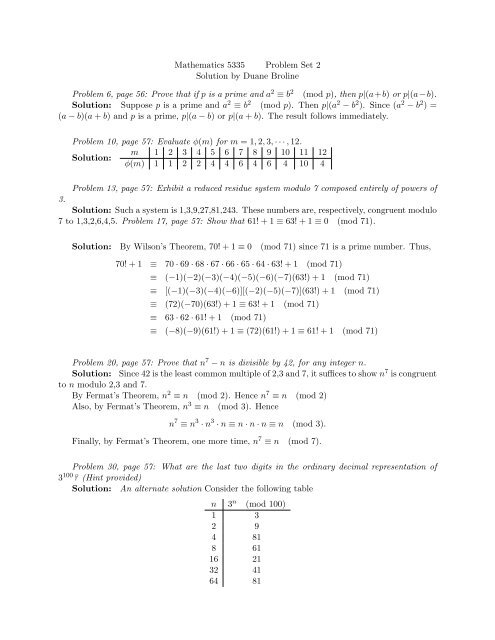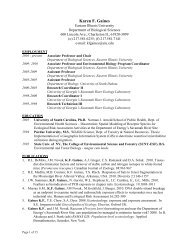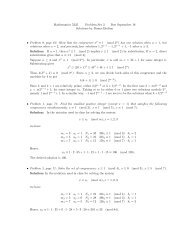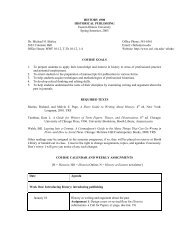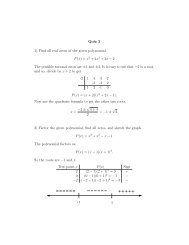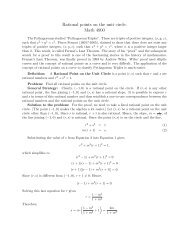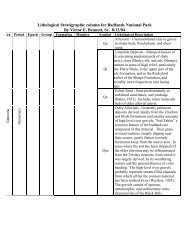Solutions - Problem Set 2
Solutions - Problem Set 2
Solutions - Problem Set 2
- No tags were found...
Create successful ePaper yourself
Turn your PDF publications into a flip-book with our unique Google optimized e-Paper software.
<strong>Problem</strong> <strong>Set</strong> 2 2Since 100 = 64 + 32 + 4,3 100 ≡≡ 3 64 3 32 3 4 ≡ 81 · 41 · 81 ≡ 1 (mod 100).You could also observe that 3 20 ≡ 3 16 · 3 4 ≡ 21 · 81 ≡ 1 (mod 100).<strong>Problem</strong> 32, page 58: Show that 2, 4, 6, · · · , 2m is a complete residue system modulo m if m isodd.Solution: It suffices to show that no two of the numbers in the list are congruent modulo m.If two such numbers are congruent, then, without loss of generality, we may assume 2i ≡ 2j(mod m), where 1 ≤ i < j ≤ m. Hence 2(j − i) ≡ 0 (mod m). Since (2, m) = 1 we have that(j − i) ≡ 0 (mod m). This is not possible since 0 < j − i < m.<strong>Problem</strong> 38, page 58: Prove that there are infinitely primes of the form 4n + 1. (Hint provided)Solution: Suppose, by way of contradiction, that p 1 , p 2 , ·p n is the list of all primes of theform 4n + 1. (Note that there is at least one such prime.) Let N = 4(p 1 p 2 · · · p n ) 2 + 1. If q|N, then(2p 1 p 2 · · · p n ) 2 ≡ −1 (mod q). This means that q = 2 or q ≡ 1 (mod 4), by Theorem 2.12. ButN has been constructed to be relatively prime to 2 and to all prime numbers of the form 4n + 1.This is a contradiction to our assumption that there are a finite number of primes of the form4n + 1.<strong>Problem</strong> 43, page 58: If p is an odd prime, prove that:1 2 · 3 2 · 5 2 · · · (p − 2) 2 ≡ (−1) (p+1)/2 (mod p)and2 2 · 4 2 · 6 2 · · · (p − 1) 2 ≡ (−1) (p+1)/2 (mod p)Solution:Now,1 2 · 3 2 · 5 2 · · · (p − 2) 2 ≡ 1(p − 1)2(p − 2) · (p − 2)(p − (p − 2)(−1) (p−1)/2 (mod p),Since there are (p − 1)/2 numbers in the list 1, 3, · · · , p − 2. Now1(p − 1)2(p − 2) · (p − 2)(p − (p − 2)(−1) (p−1)/2 ≡ (p − 1)!(−1) (p−1)/2 (mod p).Using Wilson’s Theorem,(p − 1)!(−1) (p−1)/2 ≡ (−1)(−1) (p−1)/2 ≡ (−1) (p+1)/2 (mod p).The second part of the problem is done similarly.<strong>Problem</strong> 5a, page 63: Find all solutions to the congruence 20x ≡ 4 (mod 30),Solution: We want to find x and y such that 20x+30y = 4. Since 10 = (20, 30), the existenceof such an x and y would imply that 10|4, we have a contradiction. Hence no solutions exist.<strong>Problem</strong> 5c, page 63: Find all solutions to the congruence 353x ≡ 254 (mod 400),
<strong>Problem</strong> <strong>Set</strong> 2 3Solution: Since (353, 400) = 1, there is a unique solution modulo 400. By the EuclideanAlgorithm(−15)(400) + (17)(353) = 1.It follows that 17 · 254 ≡ 318 (mod 400) is one solution to this congruence and the set of allintegers which satisfy this congruence is{318 + 400 · k: k ∈ Z}.<strong>Problem</strong> 5f, page 63: Find all solutions to the congruence 589x ≡ 209 (mod 817),Solution: By the Euclidean Algorithm, (817)(13) + (589)(−18) = 19. Multiplying throughby 11 gives (817)(143) + (589)(−198) = 209. Thus, there are 19 solutions, modulo 817, to thecongruence. One solution is −198 and the set of all integers which satisfy the congruence is{−198 + 43 · k: k ∈ Z}.<strong>Problem</strong> 6abc, page 63: How many solutions are there to each of the following congruences:(a) 15x ≡ 25 (mod 35);(b) 15x ≡ 24 (mod 35);(c) 15x ≡ 0 (mod 35)?Solution: Since (15, 35) = 5 and 5|25, there are 5 solutions modulo 35 to the first congruence.Similarly, there are 5 solutions modulo 35 to the last congruence. There are no solutions modulo35 to the second congruence.<strong>Problem</strong> 10, page 63: Show that if p is an odd prime, then the number of solutions (orderedpairs) of the congruent x 2 − y 2 ≡ a (mod p) is p − 1 unless a ≡ 0 (mod p), in which case thenumber of solutions is 2p − 1. (Hint provided)Solution: First consider the case that a ≢ 0 (mod p). LetS = {(x, y)|0 ≤ x, y ≤ p; x 2 − y 2 ≡ a(mod p)}.Claim 1: If (x, y) ∈ S, then x − y ≢ 0 (mod p).If, on the contrary, x − y ≡ 0 (mod p), thena ≡ x 2 − y 2 ≡ (x − y)(x + y) ≡ 0(mod p),contrary to the assumption that a ≢ 0 (mod p).Claim 2: If b ≢ 0, there exists a unique order pair (x, y) with 0 ≤ x, y ≤ p − 1 such thatx 2 − y 2 ≡ a (mod p) and x − y ≡ b (mod p).Now, (x, y) with 0 ≤ x, y ≤ p − 1 satisfiesif and only ifx − y ≡ b (mod p), andx 2 − y 2 ≡ a (mod p)
<strong>Problem</strong> <strong>Set</strong> 2 4x − y ≡ b (mod p), andb(x + y) ≡ (x − y)(x + y) ≡ a (mod p).If b is such that b · b ≡ 1(mod p), this last system is satisfied if and only ifx − y ≡ b (mod p), andx + y ≡ b · a (mod p)if and only ifx ≡ 2(b + b · a) (mod p)y ≡ 2(−b + b · a) (mod p)Thus, the number of elements in S is the same as the number of choices of b, where 1 ≤ b ≤ p−1.There are p − 1 such choices.Finally, consider the case that a ≡ 0 (mod p). We want to know the number of solutions,modulo p, to the congruencex 2 − y 2 ≡ 0 (mod p).This is much simpler. Now x 2 − y 2 = (x − y)(x + y). Hence (x, y) is a solution if and only if x ≡ y(mod p) or x ≡ −y (mod p). The 2p − 1 solutions in this case are{(0, 0), (1, 1), (1, p − 1), (2, 2), (2, p − 2), . . . , (p − 1, p − 1), (p − 1, 1)}.


